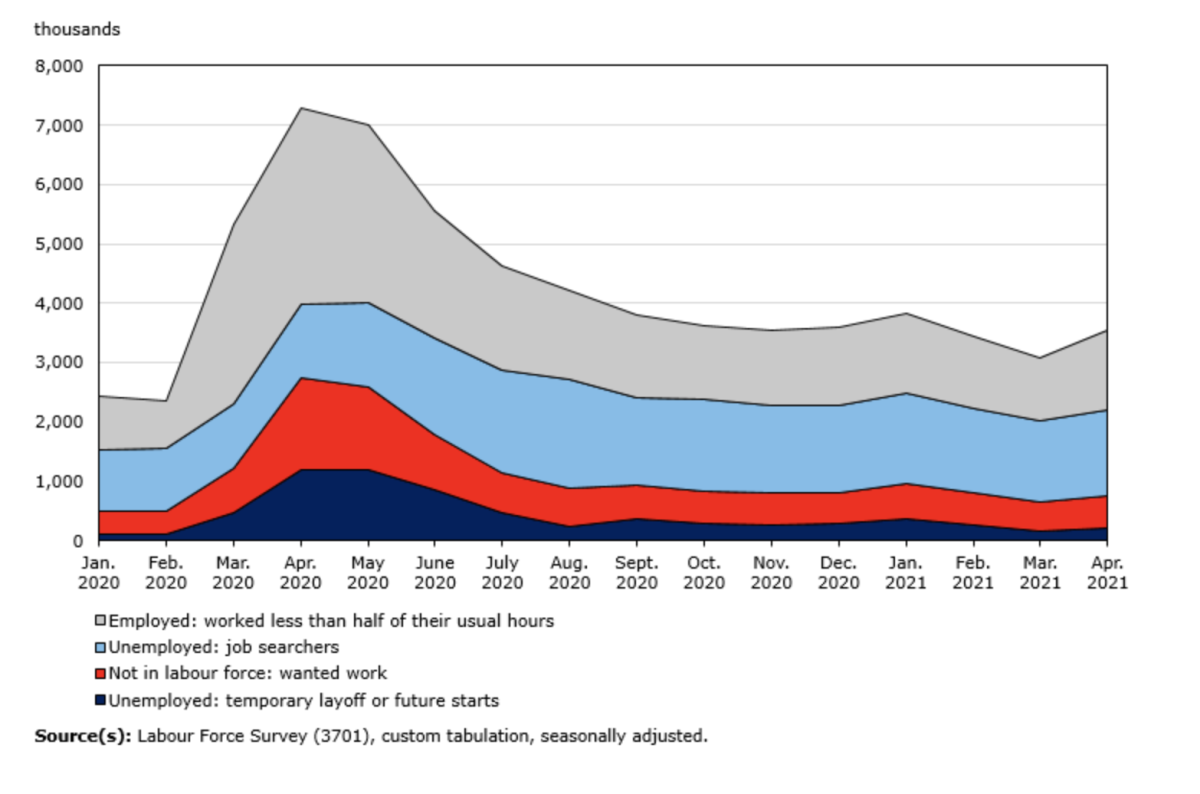Support strong Canadian climate journalism for 2025
It was an off-again job market for young workers in retail, hospitality and other high-contact industries most sensitive to fluctuating public health restrictions in April, with COVID-19’s third wave shutting down many smaller businesses across Canada.
Twice as many young workers lost jobs last month compared to the core 25- to 54-year-old labour force, Statistics Canada data released on Friday show, with Ontario’s stay-at-home order and British Columbia’s circuit breaker illustrating the divide between the fortunes of those who can and cannot work from home.
Around 101,000 people aged 15 to 24 lost work, StatCan said, mostly in those two provinces, and mostly due to the fluctuating demand for their labour in industries more prone to elasticity in line with evolving public health restrictions (and economic policy decisions).
Among the larger, older cohort, 48,000 jobs were lost, mostly full-time work done by women. Those aged 55 and older accounted for another 58,000 job losses, while another 288,000 people worked less than half their usual hours.
The precarious employment prospects of certain lower-income jobs has had knock-on effects in rental markets, where advocates fear a looming eviction crisis fed by landlords encouraged to move tenants out to catch up to market rents as some residents fight back.
The job losses among younger workers offset gains in March and left youth employment 10 per cent below the pre-pandemic level. And the outlook is just as uncertain for both high school and post-secondary workers.
“May will mark the beginning of the summer student job season — an important source of income and work experience for many youth,” the report said, pointing out that in May 2020, summer student employment was more than 40 per cent off the previous year.
“The prospects for summer jobs ... (will) ... likely depend on evolving public health measures and the safe return to in-person leisure activities,” it said.
In Ontario, the education minister has not indicated that schools will reopen before a summer break, but has said boards must offer a virtual option, with at least three-quarters of its 300 minutes a day of real-time online teaching, known as synchronous learning, for the entire 2021/22 school year.
The overall workforce is much closer to pre-pandemic conditions, but it is an unbalanced recovery that is hurting student workers.
In 2019, almost two-third of returning students who worked in the summer did so in retail, recreation, accommodation and food services, or information and culture industries.
Almost all their activities were more sharply curtailed than those in professional, scientific, and technical services, an industry grouping with almost seven per cent employment growth above its pre-COVID level.
Net employment gains of more than four per cent have been recorded in finance, insurance, real estate, rental and leasing, and public administration compared with February 2020.
The data are a snapshot of the month measured in the week of April 11 to April 17, when schools in Ontario were also closed for a delayed spring break. Some 44,000 education workers — a number that also skews younger — are contractors or temporary staffers not employed during school breaks.
Ontario has driven overall labour market trends recently, accounting for 60 per cent of the net national employment change in three of the past four months with about 40 per cent of the workforce.
Education Minister Stephen Lecce had insisted the province's schools would stay open on April 1, the same day Premier Doug Ford’s government pulled an “emergency brake” meant to stifle the movement of more virulent strains of COVID-19, which were driving a surging third wave of infections.
A week later, that was upped to a third state of emergency and provincewide stay-at-home order, in force for four weeks. On April 12, Lecce said students would be learning remotely until further notice. The emergency orders were extended on April 16 and are now due to expire on May 19.

Across the country, there were 84,000 fewer retail jobs in the month, 59,000 fewer in accommodation and food services, and 26,000 gone in information, culture and recreation.
Job losses in accommodation and food services — bars, restaurants, hotels, clubs — make up almost 71 per cent of the overall employment gap since February 2020, the last full month before restrictions were first introduced.
In addition to employment losses, the number of employed people working less than half of their usual hours increased by 288,000 (27.2 per cent).
Around three million people in Canada are currently working from home (not including those who were already working in the home, either paid or unpaid).
Morgan Sharp / Local Journalism Initiative / Canada’s National Observer







Comments
The energy and talent of our young people can be mobilized quickly not by abandoning their future to the vagaries of the market but by direct job creation that also benefits local communities.
Lower levels of government, non-profits, and social enterprise groups could administer jobs such as assistance to health care providers and seniors, educational and recreational activities for youth, public arts and culture, and environmental remediation and conservation.
These federally-funded programs can be up and running within months, useful tasks can be performed by citizens at every skill level, and the additional wage base of more working people would help underpin a private sector recovery, spreading benefits to all.
Footnote:
Some lessons from history for the design of a coronavirus fiscal intervention
http://bilbo.economicoutlook.net/blog/?p=44558
"There is no shortage of productive jobs that can be done which would be ‘safe’ in this social distancing era but would provide valuable outputs to society.
The Victorian Government announced, for example, in their – Economic Survival Package To Support Businesses And Jobs (March 21, 2020) – that:
The Government will establish a $500 million Working for Victoria Fund in consultation with the Victorian Council of Social Services and Victorian Trades Hall Council. The fund will help workers who have lost their jobs find new opportunities, including work cleaning public infrastructure or delivering food – providing vital contributions to our state’s response to the pandemic and affording those Victorians security when its needed most.
***
There is so much depleted land, infrastructure and personal care services that are required arising not only from .. natural disasters but also from years of austerity and outsources of public services.
***
There will probably be a shortage of medical support staff. Thousands of jobs could be created to ease the load in the short-term on the depleted health care ranks.
***
And if we are to protect our aged members of the population, then we could ensure they are secure in their homes with adequate food and other supplies, are able to maintain their gardens (if they have them), and attend to other needs.
***
And what about the claims that these shifts cannot be facilitated quickly enough to avoid mass unemployment?
***
The women who entered the factories in 1939 had no prior background. But productivity rose quickly.
***
There is no financial constraint preventing the Government from taking on this role."